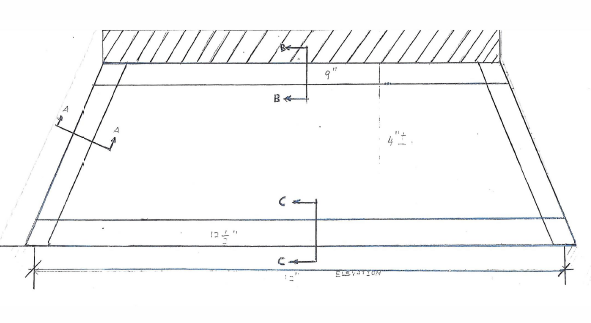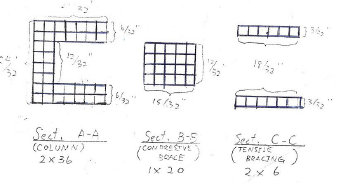Subject Area/ Grade: Statics and Strength of Materials/ Grade 12
In this civil engineering project, students will learn about the different types of trusses, strength of materials, and the behavior and force of truss members; students will then design and build a bridge from soft balsa.
Goals
Students will be able to
1. Students will be able to know the different types of trusses by DRAW TRUSSES using “Pencils, Scale, paper OR using Autodesk software like AutoCAD or REVIT.
2. Students will be able to understand the behavior of a truss members under different loads
3. Students will be able to analyze the force in members. Which member will be in tension or compression.
4. The students will be able to use Trigonometry to calculate the value of the forces to be used in designing (another class) the members using
1. The Method of JOINTS
2. The method of SECTION.
Content Area and Standards
1. Understand that the simplest truss is a triangle.
2. Understand the PYTHAGORAS Theorem to be able to analyze inclined members.
VIDEO LINK: Pythagorean theorem water demo
3. Analyze a simply supported TRUSS subjected to a given loading condition to determine reaction forces.
4. Understand the EQUATION OF EQUILIBRIUM
5. Find the values of forces in members to be used in DESIGN.
6. Students need to know some Trigonometry to be able to solve and analyze the problems.
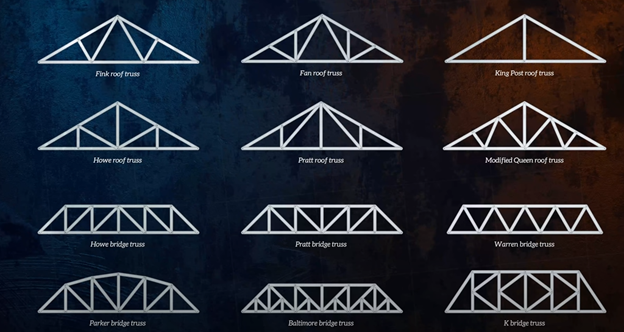
Standard 2
BM AA:: Students will develop an understanding of the core concepts of technology
Requirements involve the identification of the criteria and constraints of a product or system and the determination of how they affect the final design and development.
MB BB: Optimization is an on-going process or methodology of designing or making a product and is dependent on criteria and constraints.
Standard 4
Students will develop an understanding of the cultural, social, economic, and political effects of technology.
BMI: Making decisions about the use of technology involves weighing the trade-offs between the positive and negative effects.
BMJ: Ethical considerations are important in the development, selection, and use of technologies.
Standard 9
Students will develop an understanding of engineering design
BMI: Established design principles are used to evaluate existing designs, to collect data, and to guide the design process.
BM J: Engineering design is influenced by personal characteristics, such as creativity, resourcefulness, and the ability to visualize and think
abstractly.
BM L: Decisions regarding the implementation of technologies involve the weighing of tradeoffs between predicted positive and
negative effects on the environment.
Standard 11
Students will develop abilities to apply the design process.
BM M: Identify the design problem to solve and decide whether or not to address it.
BM N: Identify criteria and constraints and determine how these will affect the design process
BM O: Refine a design by using prototypes and modeling to ensure quality, efficiency, and productivity of the final product.
BM P: Evaluate the design solution using conceptual, physical, and mathematical models at various intervals of the design process in order to check for proper design and to note areas where improvements are needed
BM Q: Develop and produce a product or system using a design process.
Activity
1. STUDENTS WILL BE ASKED TO SKETCH OR TAKE A PICTURE OF ANY STRUCTURE (truss)
2. WATCH VIDEO TO UNDERSTAND THE CONTENTS
VIDEO LINK Understanding and Analysing Trusses
3. WATCH VIDEO TO UNDERSTAND OF THE SIDE EFFECT OF MISTAKES CARRIED OUT BY THE DESIGNER ON PUBLIC
VIDEO LINK: Pedestrian Bridge Collapse Over SW 8th Street HWY18MH009
Balsa Wood Bridge
Objective: To design and build a bridge so it has as high a strength-weight ratio as possible and follows the following Specifications:
1. The bridge shall be constructed from only 3/32” x 3/32” soft balsa wood and any type of glue or surface application.
2. The bridge shall be supported by two wood piers spanning 15” at the same elevation.
3. No part of the bridge may extend below the pier elevation
4. The load shall be applied by a wood plate centered on the span
5. The maximum width of the bridge at either end shall be 3-1/8”. The maximum height of the bridge shall be 4”
Joy2Learn Artists /Videos that Support Project
Session 1:
Practice the skills: Gampel Intro
Article: 4 Myths about Creativity: https://www.edutopia.org/article/4-myths-about-creativity
Session 2:
Article: Divergent & Convergent thinking by Sara Smith
Link:https://www.fablevisionlearning.com/creativity-blog/2018/12/divergent-and-convergent-thinking
Article: Your Brain Can Only Take So Much Focus
by Srini Pillay Link:https://hbr.org/2017/05/your-brain-can-only-take-so-much-focus
Video: Richard Serra, Sculptor-Richard the Artist
Link: Sculpture with Richard Serra
Session 3:
Alan Gampel (PIANIST)
Video: Develop Technical Skills
Link: Piano with Alan Glampel
Alan Gampel (PIANIST)
Video: Knowing the history of what you do and practice and do
Link: Piano with Alan Glampel
Elizabeth Murry (Painter)
Video: Early Drawing
Link: Painting with Elizabeth Murray
Elizabeth Murry Painter
Video: Ambitions
Link:Painting with Elizabeth Murray
Elizabeth Murry Painter
Video “ NOTEBOOK”
Link:Painting with Elizabeth Murray
Article by Youki Terada
The Science of Drawing and Memory
Link: https://www.edutopia.org/article/science-drawing-and-memory
Article by “New York Times” Matt Richtel
HOW TO BE CREATIVE
Link: https://www.nytimes.com/guides/year-of-living-better/how-to-be-creative
Session 4:
Video: Hector Elizondo
The importance of the words.
Link:Acting with Hector Elizondo
Video: Hector Elizondo
An Actor Transformation
Link:Acting with Hector Elizondo
Video: Hector Elizondo.
Use of Language.
Link:Acting with Hector Elizondo
Video: Hector Elizondo
Conclusion.
Link: Acting with Hector Elizondo
Article by Linda Flanagan,
How Improv Can Open Up the Mind to Learning in the Classroom and Beyond.
Link:https://www.kqed.org/mindshift/39108/how-improv-can-open-up-the-mind-to-learning-in-the-classroom-and-beyond
Article by HARVARD GRADUATE SCHOOL OF EDUCATION
Step Inside: Perceive, Know About, Care About.
Link: http://www.pz.harvard.edu/sites/default/files/Step%20Inside_2.pdf
Article by A.J.Juliani.
Why “20% Time” Is Good for Schools
Link: https://www.edutopia.org/blog/20-percent-time-a-j-juliani
Article by Dan Ryder.
What One Word Can Do: a Pathway to Critical Creativity in Any Classroom
Link:https://medium.com/@WickedDecent/what-one-word-can-do-a-pathway-to-critical-creativity-in-any-classroom-a38d8eb326fb
Article by Amy schwarzbach-Kang
Learning Math by Seeing It as a Story.
Link: https://www.edutopia.org/article/learning-math-seeing-it-story
Session 5
Video:Gregory Hines:
Videos: Hector Elizondo
Videos: Frank Gehry
Session 6
Video: Hilda Morgan
Cultural diversity The Sum of Our Parts (Madness and Miracles)
https://ed.ted.com/on/ab24SZOt
NOTE: After watching the video: I am very much related to each word HIDA said in her video. At all times I ask myself WHO AM I?
Video: Pusarla Venkata Sindhu
Ideas worth spreading
https://www.ted.com/talks/pusarla_venkata_sindhu_limitless/recommendations/23926
How to get students inspired and NEVER GIVE UP!!!
Art Forms that May Be Included
Drawing & Sketching
Connections to Students Passion Areas and Interests
Materials Needed
Collaborators
Assessment
Using a RUBRIC to assess the outcome of The BALSA WOOD Project
Timeline
Two week of classwork. One period a day. 45 minutes per period.
(I am very much open to giving extra time if needed.)
Other Notes
How to Launch the sessions, and where we find it?:
1.Introduction from (ME) to class to what a truss is?
Members connect together through a join which will carry only tension force or compression force.
Example of our body.
Hands and legs are members connecting to joints which only can handle compression OR tension. One at the time. Hands and legs as a
truss member can not handle tension and compression at the same time. IT IS EITHER OR!!! We can not bend our arms and legs. We will
have pain due to any bending. So, this is how the truss members will behave under loads.
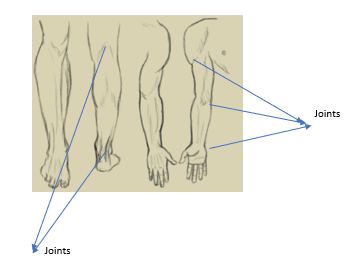
2.Students will sketch and draw with colored pencils any structure they will see on their way to school using their ENGINEERING NOTES. Examples: (Bridges, or maybe a roof or ceiling of a Homedepot store, Some train stations have trusses.)
3.Next day: Students will be able to describe the sketches from their ENGINEERING NOTES.
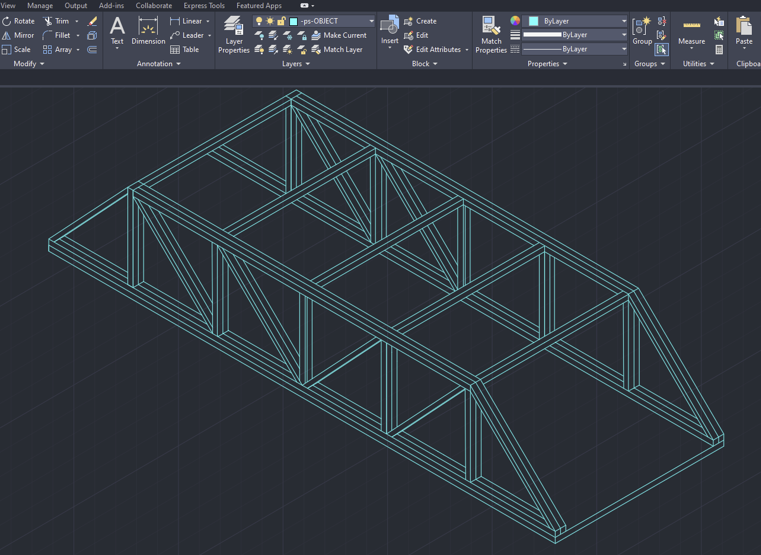
4. Students will draw their sketch using AutoCAD (They had AutoCAD the year before they joined the class).
5. I used to take a trip with my class to”TACONY-PALMYRA BRIDGE” before having this lesson. If I am not able to do it I will show them that VIDEO
Tacony-Palmyra Bridge Opening
And that video
Tacony Palmyra Bridge – ship passing
And that video for a previous trip from my school (BROOKLYN TECH. HS)
Tacony Palmyra Bridge Visit – Brooklyn Tech (Civil & Architect)
As you can see the Bridge Engineer explained the function of how the bridge operate using some engineering terminology.
During the trip students will sketch in their ENGINEERING NOTES how they saw the bridge.
6. Students will search online about the history of TRUSSES.
7. Introducing the BALSA WOOD PROJECT
Balsa Wood Bridge
Objective: To design and build a bridge so it has as high a strength-weight ratio as possible and follows the following Specifications:
1. The bridge shall be constructed from only 3/32” x 3/32” soft balsa wood and any type of glue or surface application.
2. The bridge shall be supported by two wood piers spanning 15” at the same elevation.
3. No part of the bridge may extend below the pier elevation
4. The load shall be applied by a wood plate centered on the span
5. The maximum width of the bridge at either end shall be 3-1/8”. The maximum height of the bridge shall be 4”.
And supply them with materials. They will work on it in pairs in class.
